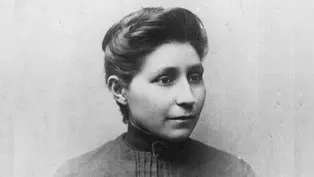
What’s causing widespread drug shortages in the U.S.
Clip: 11/5/2023 | 6m 9sVideo has Closed Captions
What’s causing the unusually high number of drug shortages in the U.S.
Shortages of over-the-counter drugs and prescription medications for ADHD, cancer and diabetes have been disrupting hospitals and pharmacies for the past year. Now, RSV treatments for infants are the latest to be affected. Michael Ganio, a senior director at the American Society of Health-System Pharmacists, joins Ali Rogin to discuss what’s driving the shortages and what can be done about it.
Major corporate funding for the PBS News Hour is provided by BDO, BNSF, Consumer Cellular, American Cruise Lines, and Raymond James. Funding for the PBS NewsHour Weekend is provided by...

What’s causing widespread drug shortages in the U.S.
Clip: 11/5/2023 | 6m 9sVideo has Closed Captions
Shortages of over-the-counter drugs and prescription medications for ADHD, cancer and diabetes have been disrupting hospitals and pharmacies for the past year. Now, RSV treatments for infants are the latest to be affected. Michael Ganio, a senior director at the American Society of Health-System Pharmacists, joins Ali Rogin to discuss what’s driving the shortages and what can be done about it.
How to Watch PBS News Hour
PBS News Hour is available to stream on pbs.org and the free PBS App, available on iPhone, Apple TV, Android TV, Android smartphones, Amazon Fire TV, Amazon Fire Tablet, Roku, Samsung Smart TV, and Vizio.
Providing Support for PBS.org
Learn Moreabout PBS online sponsorshipJOHN YANG: All year long, drug shortages have disrupted hospitals and pharmacies.
Medications for ADHD, chemotherapy and diabetes, among others, have constantly been in low supply.
And now RSV treatments for infants are the latest to be affected.
Ali Rogin tells us whatús driving the shortages and what could be done about it.
ALI ROGIN: If youúve recently struggled to get a prescription filled or buy certain over-the-counter medicines, youúre not alone.
By late spring this year, there were 309 ongoing drug shortages in the US.
The highest in nearly a decade.
Experts blame supply chain gaps, manufacturing delays, and spikes in demand for the shortages.
But what does that mean for doctors, parents, and patients who are caught in the middle?
Michael Ganio is a senior director at the American Society of Health System Pharmacists.
Thank you so much for joining us.
Michael, drug shortages are not that uncommon, but to have so many at one time is what are some of the factors contributing to the situation?
MICHAEL GANIO, American Society of Health-System Pharmacists: Well, there are several reasons for drug shortages.
What weúve seen recently are some demand spikes.
As you noted, there are weight loss medications used for diabetes.
Thereús unprecedented demand for those attention deficit and hyperactivity disorder medications commonly known as Adderall or Ritalin, those have been in short supply because of high demand.
The other side of that is manufacturing delays, and sometimes itús a disruption due to quality.
Itús not a problem with the quality of the product, but itús a process issue that has held up production.
And if anyone has heard of the ongoing oncology drug shortages, things we use to treat cancers, chemotherapy drugs, those have been caused because of some of these quality issues prohibiting release of the products.
So really, there are a lot of different causes, and weúve even seen geopolitical threats to the supply chain.
And of course, during COVID-19, we had supply chain disruptions across the board.
ALI ROGIN: I want to talk more about the cancer drug shortage that you mentioned.
How are hospitals, how are doctors dealing with that?
MICHAEL GANIO: These shortages are really challenging, mostly because itús not easy to just switch between drugs.
Usually when weúre out of a drug, we have to switch regimens completely.
And that means that thereús different outcomes that can be associated with those regimens.
They may not be as effective.
They may have different or worse side effects.
And so really thereús a decision that has to be made when deciding who gets that treatment.
Is there a curative intent?
Is there a chance that weúll cure that cancer?
Or are we doing something to try to prolong their overall survival?
That may play into which patients get the drug and which ones donút?
ALI ROGIN: Letús talk now about the antibody treatment that was approved for RSV.
There are shortages there too.
How is that affecting patients?
MICHAEL GANIO: Well, this one is also an unusual one.
This is an increase in demand causing the shortage.
And actually, to say increase is a little bit of a misnomer because itús a new drug.
Thereús really no precedent set as far as demand.
So the manufacturer tried to project how much of the medication would be used, and itús obvious that they did not project enough to manufacture enough to treat all the patients that they planned to treat.
There are actually several things at play.
You may just look at birthing numbers and wonder, well, looking at these statistics, why didnút they forecast enough?
But they had to order a lot of this drug ahead of time to know how much to make.
The other variable is the fact that there is a vaccine available.
And if the mother receives a vaccine within a certain time frame, the child does not need this monoclonal antibody.
So, what we will hopefully see is, as the season goes on, more mothers receive that vaccine, and then the infant is born, protected already, and will not need this antibody.
But for right now, thereús a really high demand for that drug.
ALI ROGIN: Now, we know there are several federal agencies involved in dealing with these shortages.
The FDA has a role to play, HHS, even the Department of Defense.
How can those different agencies work together to put a stop to this?
MICHAEL GANIO: Well, they already have worked together a little bit.
Back in 2018 and into 2019, several agencies worked together to develop a report on the root causes of drug shortages.
Two of the root causes that are really interesting that weúre focused on are the economics of the drug shortage problem.
Weúre talking about a lot of older, generic, sterile, injectable drugs.
These are difficult to manufacture because of the sterility, but they also have very slim profit margins.
So thereús really not a lot of economic interest in getting into this market or expanding a portfolio into this market.
The other side of that is quality.
When weúre purchasing the drugs, we donút really have any insight into that quality.
With our FDA system of pass fail approval, we have to assume everything is equal.
So we really have no other piece of information to base purchasing on other than the price that leads to a race to the bottom in pricing, and it incentivizes hospitals and other providers to buy the cheapest product.
ALI ROGIN: And I know thatús something that you at the American Society of Health-Systems Pharmacists has been pushing to get implemented, something that would allow you to factor in quality, not just low prices.
Tell me more about that.
And what other solutions, on a policy level do you think need to be implemented to avoid future drug shortages like this?
MICHAEL GANIO: The key is providing purchasers with more information about the products weúre buying.
How much investment in the resiliency of the supply chain?
Are they using multiple sources for the active pharmaceutical ingredient?
Do they have redundancies built into their systems?
And if they do, then the market should reward that.
And maybe that marginal increase in price is something that providers will pay.
We do know that drug shortages cost the United States healthcare system quite a bit of money.
There was a survey in 2019 that estimated about 360 million healthcare dollars in the U.S. are spent every year just in labor costs.
So the marginal increase on the price of a generic injectable is something that buyers may invest in if they know that itús going to help resolve these shortages.
ALI ROGIN: Michael Ganio with the American Society of Health-System Pharmacists.
Thank you so much for your time.
MICHAEL GANIO: Thank you for having me.
The 1st Native American medical doctor’s life and legacy
Video has Closed Captions
How Susan La Flesche Picotte became the 1st Native American medical doctor (3m 30s)
Gazans flee south as Israel’s military encircles Gaza City
Video has Closed Captions
Gaza residents flee south as Israel’s military encircles Gaza City (4m 37s)
Israel’s judicial reform protest groups shift focus to aid
Video has Closed Captions
How Israel’s judicial reform protesters shifted focus to aiding victims of Hamas (6m 46s)
Providing Support for PBS.org
Learn Moreabout PBS online sponsorshipMajor corporate funding for the PBS News Hour is provided by BDO, BNSF, Consumer Cellular, American Cruise Lines, and Raymond James. Funding for the PBS NewsHour Weekend is provided by...















